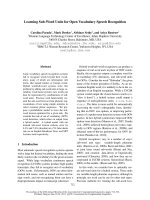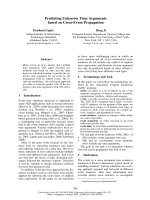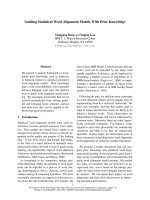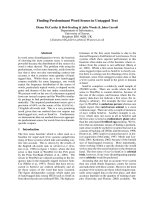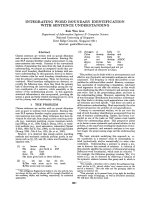Báo cáo khoa học: "Chinese Unknown Word Identification Using Character-based Tagging and Chunking" docx
Bạn đang xem bản rút gọn của tài liệu. Xem và tải ngay bản đầy đủ của tài liệu tại đây (64.54 KB, 4 trang )
Chinese Unknown Word Identification Using Character-based Tagging and
Chunking
GOH Chooi Ling, Masayuki ASAHARA, Yuji MATSUMOTO
Graduate School of Information Science
Nara Institute of Science and Technology
ling-g,masayu-a,matsu @is.aist-nara.ac.jp
Abstract
Since written Chinese has no space to de-
limit words, segmenting Chinese texts be-
comes an essential task. During this task,
the problem of unknown word occurs. It is
impossible to register all words in a dictio-
nary as new words can always be created
by combining characters. We propose a
unified solution to detect unknown words
in Chinese texts. First, a morphological
analysis is done to obtain initial segmen-
tation and POS tags and then a chunker is
used to detect unknown words.
1 Introduction
Like many other Asian languages (Thai, Japanese,
etc), written Chinese does not delimit words by
spaces and there is no clue to tell where the word
boundaries are. Therefore, it is usually required to
segment Chinese texts prior to further processing.
Previous research has been done for segmentation,
however, the results obtained are not quite satisfac-
tory when unknown words occur in the texts. An
unknown word is defined as a word that is not found
in the dictionary. As for any other language, all pos-
sibilities of derivational morphology cannot be fore-
seen in the form of a dictionary with a fixed number
of entries. Therefore, proper solutions are necessary
for the detection of unknown words.
Along traditional methods, unknown word detec-
tion has been done using rules for guessing their
location. This can ensure a high precision for the
detection of unknown words, but unfortunately the
recall is not quite satisfactory. It is mainly due to
the Chinese language, as new patterns can always
be created, that one can hardly efficiently maintain
the rules by hand. Since the introduction of statis-
tical techniques in NLP, research has been done on
Chinese unknown word detection using such tech-
niques, and the results showed that statistical based
model could be a better solution. The only resource
needed is a large corpus. Fortunately, to date, more
and more Chinese tagged corpora have been created
for research purpose.
We propose an “all-purpose” unknown word de-
tection method which will extract person names, or-
ganization names and low frequency words in the
corpus. We will treat low frequency words as gen-
eral unknown words in our experiments. First, we
segment and assign POS tags to words in the text
using a morphological analyzer. Second, we break
segmented words into characters, and assign each
character its features. At last, we use a SVM-based
chunker to extract the unknown words.
2 Proposed Method
We shall now describe the 3 steps successively.
2.1 Morphological Analysis
ChaSen is a widely used morphological analyzer for
Japanese texts (Matsumoto et al., 2002). It achieves
over 97% precision for newspaper articles. We as-
sume that Chinese language has similar characteris-
tics with Japanese language to a certain extent, as
both languages share semantically heavily loaded
characters, i.e. kanji for Japanese, hanzi for Chinese.
Based on this assumption, a model for Japanese may
do well enough on Chinese. This morphological an-
alyzer is based on Hidden Markov Models. The tar-
get is to find the word and POS sequence that max-
imize the probability. The details can be found in
(Matsumoto et al., 2002).
2.2 Character Based Features
Character based features allow the chunker to detect
unknown words more efficiently. It is especially the
case when unknown words overlap known words.
For example, ChaSen will segment the phrase ”
” (Deng Yingchao before death) into
” / / / / ” (Deng Ying before next life). If
we use word based features, it is impossible to detect
the unknown person name ”
” because it will
not break up the word ” ” (next life). Breaking
words into characters enables the chunker to look at
characters individually and to identify the unknown
person name above.
The POS tag from the output of morphological
analysis is subcategorized to include the position of
the character in the word. The list of positions is
shown in Table 1. For example, if a word contains
three characters, then the first character is
POS -B,
the second is
POS -I and the third is POS -E. A
single character word is tagged as POS -S.
Table 1: Position tags in a word
Tag Description
S one-character word
B first character in a multi-character word
I intermediate character in a multi-
character word (for words longer than
two characters)
E last character in a multi-character word
Character types can also be used as features for
chunking. However, the only information at our dis-
posal is the possibility for a character to be a fam-
ily name. The set of characters used for translitera-
tion may also be useful for retrieving transliterated
names.
2.3 Chunking with Support Vector Machine
We use a Support Vector Machines-based chunker,
YamCha (Kudo and Matsumoto, 2001), to extract
unknown words from the output of the morphologi-
cal analysis. The chunker uses a polynomial kernel
of degree 2. Please refer to the paper cited for de-
tails.
Basically we would like to classify the characters
into 3 categories, B (beginning of a chunk), I (inside
a chunk) and O (outside a chunk). A chunk is con-
sidered as an unknown word in this case. We can
either parse a sentence forwardly, from the begin-
ning of a sentence, or backwardly, from the end of
a sentence. There are always some relationships be-
tween the unknown words and the their contexts in
the sentence. We will use two characters on each left
and right side as the context window for chunking.
Figure 1 illustrates a snapshot of the chunking
process. During forward parsing, to infer the un-
known word tag “I” at position i, the chunker uses
the features appearing in the solid box. Reverse is
done in backward parsing.
3 Experiments
We conducted an open test experiment. A one-
month news of year 1998 from the People’s Daily
was used as the corpus. It contains about 300,000
words (about 1,000,000 characters) with 39 POS
tags. The corpus was divided into 2 parts randomly
with a size ratio for training/testing of 4/1.
All person names and organization names were
deleted from the dictionary for extraction. There
were 4,690 person names and 2,871 organization
names in the corpus. For general unknown word,
all words that occurred only once in the corpus were
deleted from the dictionary, and were treated as un-
known words. 12,730 unknown words were created
under this condition.
4 Results
We now present the results of our experiments in re-
call, precision and F-measure, as usual in such ex-
periments.
4.1 Person Name Extraction
Table 2 shows the results of person name extraction.
The accuracy for retrieving person names was quite
satisfiable. We could also extract names overlap-
ping with the next known word. For example, for
the sequence “
/Ng /Ag /v /f /v /v
Position Char. POS(best) Family Name Chunk
i - 2 n-S Y B
i - 1 Ag-S N I
i Ng-S N I
i + 1
n-B N O
i + 2 n-E Y O
Figure 1: An illustration of chunking process ‘President Jiang Zemin’
/u /n” (The things that Deng Yingchao used
before death), the system was able to correctly re-
trieve the name “ ” although the last character
is part of a known word “ ”. It could also iden-
tify transliterated foreign names such as “ ”
(Filali)
1
, “ . ” (Frank Kahn)
2
, “ ”
(Boraine)
3
, etc.
Table 2: Results for person name extraction
Recall Precision F-measure
For 83.37 86.06 84.69
Back 79.45 86.84 82.98
+FamN/For 85.81 87.52 86.66
+FamN/Back 84.44 89.25 86.78
For - forward parsing, Back - backward parsing, +FamN
- add family name as feature
Furthermore, it was proved that if we have the in-
formation that a character is a possible character for
family name, it helps to increase the accuracy of the
system, as the last two rows of Table 2 show.
Some person names that could not be extracted
are such as in the sequence “
/a /q /d /d
/a” (Lao Zhang is still very positive). In this ex-
ample, “ ” was extracted as a person name,
however the right name is “ ” only. This is be-
cause the next character of the unknown ones is a
monosyllabic word, thus there is higher possibility
that it is joined with the unknown word as a chunk.
Another example is “ /q /v /n /n” (The
owner Zhang Baojun), where the family name “ ”
has been joined with the known word “ ” (sug-
gest) before it. Therefore, the person name “ ”
was not extracted (the correct segmentation should
be “ /n /nr”).
1
the former Prime Minister of Morocco
2
Western Cape Attorney General of South Africa in 1998
3
Truth Commission Deputy Chairman in 1998
4.2 Organization Name Extraction
Table 3 shows the result for organization name ex-
traction. Organization names are best extracted by
using backward parsing. This may be explained by
the fact that, in Chinese, the last section of a word
is usually the keyword showing that it is an orga-
nization name, such as, “
” (company), “ ”
(group), “ ” (organization), etc. By parsing the
sentence backwardly, these keywords will be first
looked at and will have higher possibility to be iden-
tified.
Table 3: Results for organization name extraction
Recall Precision F-measure
For 54.66 70.85 61.71
Back 63.25 79.36 70.40
There are quite a number of organization names
that could not be identified. For example, “
” (Xiangfan City Zhida Car Rental
Company), “ ”
(Shanghai Zhuang Mother Jingcaishe Service Lim-
ited Company). This could be because the names
are too long, and the 2 characters left and right con-
text window is not enough for the system to make a
correct judgement.
4.3 Unknown Words Extraction in General
As mentioned above, we deleted all words that occur
only once from the dictionary to artificially create
unknown words. Those “unknown words” included
common nouns, verbs, numbers, etc. The results for
this experiment are shown in Table 4.
In general, around 60% accuracy (F-measure) was
achieved for unknown word detection, and back-
ward parsing seems doing slightly better than for-
ward parsing.
Table 4: Results for unknown word extraction in
general
Recall Precision F-measure
For 56.77 65.28 60.70
Back 58.43 63.82 61.00
5 Comparison with Word Based Chunking
As to ensure that character based chunking is better
than word based chunking, we have carried out an
experiment with word based chunking as well.
The results showed that character based chunking
yields better results than word based chunking. The
f-measure (
word based vs character based )
for person name extraction is (81.28 vs 84.69), for
organization name is (67.88 vs 70.40), and for gen-
eral unknown word is (56.96 vs 61.00) respectively.
6 Comparison with Other Works
There are basically two methods to extract unknown
words, statistical and rule based approaches. In this
section, we compare our results with previous re-
ported work.
(Chen and Ma, 2002) present an approach that au-
tomatically generates morphological rules and sta-
tistical rules from a training corpus. They use a very
large corpus to generate the rules, therefore the rules
generated can represent patterns of unknwon words
as well. While we use a different corpus for the
experiment, it is difficult to perform a comparison.
They report a precision of 89% and a recall of 68%
for all unknown word types. This is better than our
system which achieves only 65% for precision and
58% for recall.
In (Shen et al., 1997), local statistics information
are used to identify the location of unknown words.
They assume that the frequency of the occurences of
an unknown word is normally high in a fixed cache
size. They have also investigated on the relationship
between the size of the cache and its performance.
They report that the larger the cache, the higher the
recall, but not the case for precision. They report a
recall of 54.9%, less than the 58.43% we achieved.
(Zhang et al., 2002) suggest a method that is
based on role tagging for unknown words recogni-
tion. Their method is also based on Markov Mod-
els. Our method is closest to the role tagging idea as
this latter is also a sort of character based tagging.
The extension in our method is that we first do mor-
phological analysis and then use chunking based on
SVM for unknown word extraction. In their paper,
they report an F-measure of 79.30% in open test en-
vironment for person name extraction. Our method
seems better with an F-measure of 86.78% for per-
son name extraction (for both Chinese and foreign
names).
7 Conclusion
We proposed an “all-purpose” method for Chinese
unknown word detection. Our method is based on
an morphological analysis that generates segmenta-
tions and POS tags using Markov Models, followed
by a chunking based on character features using
Support Vector Machines. We have also shown that
character based features yields better results than
word based features in the chunking process. Our
experiments showed that the proposed method is
able to detect person names and organization names
quite accurately and is also quite satisfactory even
for low frequency unknown words in the corpus.
References
Keh-Jiann Chen and Wei-Yun Ma. 2002. Un-
known Word Extraction for Chinese Documents. In
COLING-2002: The 19th InternationalConference on
Computational Linguistics Vol. 1, pages 169–175.
Taku Kudo and Yuji Matsumoto. 2001. Chunking with
Support Vector Machines. In Proceedings of NAACL
2001.
Yuji Matsumoto, Akira Kitauchi, Tatsuo Yamashita,
Yoshitaka Hirano, Hiroshi Matsuda, KazumaTakaoka,
and Masayuki Asahara. 2002. Morphological Analy-
sis System ChaSen version 2.2.9 Manual. Nara Insti-
tute of Science and Technology.
Dayang Shen, Maosong Sun and Changning Huang.
1997. The application & implementation of local
statistics in Chinese unknown word identification. In
COLIPS, Vol. 8. (in Chinese).
Kevin Zhang (Hua-Ping Zhang), Qun Liu, Hao Zhang,
and Xue-Qi Cheng. 2002. Automatic Regcognition
of Chinese Unknown Words Based on Roles Tagging.
In Proceedings of 1st SIGHAN Workshop on Chinese
Language Processing.

